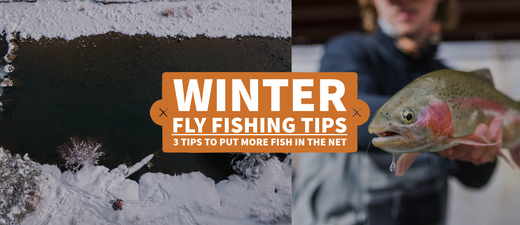Winter fly fishing can be incredibly rewarding, but it comes with its own set of challenges. As temperatures drop, fish behavior changes, and so must your tactics. Here are three essential tips to help you maximize your chances of success and bring more fish to the net during the colder months.
1. Sleep In: The Fish Are Cold
One of the biggest mistakes anglers make in the winter is hitting the water too early. During winter, water temperatures are at their lowest in the morning, making fish sluggish and less likely to feed actively. The best time to fish in winter is between 11:00 am and 2:00 pm, when the sun has had time to warm up the water and raise water temps.
Additionally, sunny days are your friend during winter fly fishing. The extra sunlight warms the water faster, which can trigger hatches resulting in a spike in fish activity. Look for stretches of water that receive plenty of sunlight, and don’t rush to hit the river at dawn—a leisurely start to your day can lead to more productive fishing.
Fishpond Riverkeeper Digital Thermometer
PRO TIP: Keep a river thermometer on you in the winter season to take water temps throughout the day. This allows you to have an understanding of whats going on and what the fish are doing. This allows you to make adjustments such as moving locations, adjusting your presentation, changing flies, and more.
2. Increase Your Bite Detection
In winter, trout’s metabolism slows down, leading to softer strikes that can be hard to detect. Increasing your bite detection is crucial to ensure you don’t miss these subtle takes. Here’s how:
-
Choose the Right Indicator: A sensitive and highly visible strike indicator can make all the difference. Experiment with smaller or lighter indicators to pick up on those faint winter takes. Our go-to indicator for the winter months is the New Zealand Indicator. This indicator kit allows you to easily adjust the size of your indicator to match the weight of the flies below ensuing maximum sensitivity.
-
Use Smaller Tippet Sizes: Dropping your tippet size from 4x to 5x or even 6x can improve your presentation and increase the chances of enticing a bite. Smaller tippets allow your flies to drift more naturally in slow-moving water, which is key during winter months.
3. Slow Water is Winter Water
In winter, trout seek out areas where they can conserve energy while still having access to food. This means targeting slower, deeper water is essential.

-
Focus on Deep Holes: Trout often hold in deeper pools where they can rest and feed without expending too much energy. Use weighted flies or split shot to get your presentation down to where the fish are.
-
Avoid Faster Riffles: While fast riffles are productive in the warmer months, the faster currents require more energy for fish to navigate, making them less appealing in winter. Instead, concentrate your efforts on the edges of the faster water and eddies where trout can feed comfortably.
Final Thoughts
Winter fly fishing is all about adapting to the conditions and understanding how trout behave in colder water. By fishing during the warmest part of the day, improving your bite detection, and targeting slower water, you’ll set yourself up for a successful and enjoyable winter fishing experience. So dress warm, grab a beer, and enjoy the quiet and rewarding winter season on the river.



